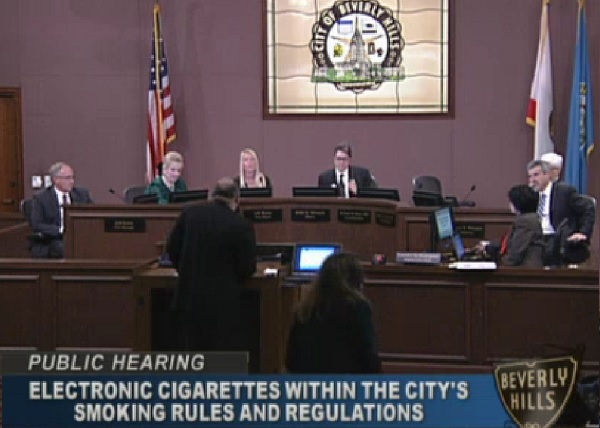
The city of Beverly Hills recently proposed a pair of ordinances which would ban the usage of e-cigarettes in places where smoking is already outlawed and place a temporary ban on their sale pending further investigation into their safety. The usage ban was set to treat e-cigarettes exactly the same as cigarettes in terms of use in public places (including mandatory minimum distances from the main entrance and open windows in public buildings), and the moratorium proposed for sales was effectively giving retailers two weeks to clear out their stock before imposing a temporary ban which could theoretically be extended up to a maximum of two years.
Moreover, these proposals were deemed “urgent,” thus presenting an effective fast-track if four out of five council members approved. The justification for this “urgency” is unclear, as Tracy Oppenheimer of Reason magazine humorously pointed out, but the implications for vapers and retailers in Beverly Hills are downright horrendous. To clarify, you could still go out and buy a packet of carcinogenic cigarettes if the ordinance was to pass. That wasn't the priority, apparently.
CASAA did their thing and put out a helpful Call to Action regarding the meeting held on the 5th of November, which you can watch below or online (the e-cig portion starts at around two hours in), and features comments from the public before the council-members discuss the ordinances (at around 3:10).
Thankfully for vapers in Beverly Hills, the ordinances didn’t pass, and the next news on the issue will likely be the result of the Health and Safety Commission’s investigation into the topic (on November 25th). The debate may have gone well for the vaping community, but the issues have deeper implications in terms of regulatory thinking on the topic.
Here’s a summary of what happened at the hearing:
- Just one public speaker favored the proposals.
- The vast majority told their personal stories of quitting smoking thanks to e-cigs.
- Vapers presented scientific research on the safety of e-cigs to the Council for consideration.
- Business owners opposed the needless limitation on their stock.
- John Cameron (former CEO of Safe Cig) argued that e-cigs are the first technology that may finally reduce the suffering caused by smoking.
- Council member Nancy Krasne favors indoor usage ban, because she believes there could be risks to bystanders, and it may make smoking “look cool” again to kids. She opposed the sales ban, however.
- Dr. Gold favored the proposals – claiming it’s better to enforce a ban now than allow people to expose themselves to “potential danger.”
- Vice Mayor Lili Bosse questioned the urgency of the proposals, and preferred to wait until the data was in to consider enacting any sort of ban.
- Mayor John Mirisch finds the idea of banning e-cigarettes sales and leaving cigarette sales untouched too inconsistent to ever support. He mainly favors usage restrictions in restaurants, but agrees regulations should come after evidence of harm, not before.
- The ordinances did not receive support by council members other than Dr. Gold, and have therefore not passed at this time.
- Dr. Gold – and many others opposed to e-cigs – use the precautionary principle without considering the potential public health implications of an unjustified e-cig ban.
Highlights from Public Comment
Even before the meeting took place they had received a lot of correspondence regarding the proposed ordinances, obviously from vapers disgusted at the nature of the sales ban and questioning the rationality of an indoor usage ban. The turnout for the meeting was solid, and as the first public commenter approached the council, you’d have been forgiven for expecting a torrent of abuse about the absurd nature of the proposals.
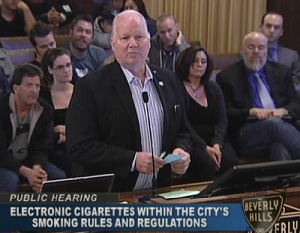 The first speaker, however, was in favor of the usage ban. He repeated that nicotine was a poison, and that since the vapor contained nicotine, people shouldn’t be exposed to it. He referenced the Harvard study (conducted in Greece), which found evidence of an increase in airway resistance after using an e-cig. He told a story of when somebody was vaping at a table beside him in a New York restaurant, politely blowing vapor away from his their own table but inadvertently sending the vapor towards the speaker. He described this as “nauseating.”
The first speaker, however, was in favor of the usage ban. He repeated that nicotine was a poison, and that since the vapor contained nicotine, people shouldn’t be exposed to it. He referenced the Harvard study (conducted in Greece), which found evidence of an increase in airway resistance after using an e-cig. He told a story of when somebody was vaping at a table beside him in a New York restaurant, politely blowing vapor away from his their own table but inadvertently sending the vapor towards the speaker. He described this as “nauseating.”
That warranted a fairly detailed description, because he was the only public speaker in favor of the proposals. From that moment onwards, the public comment was a relentless torrent of the things you will have been thinking upon first reading the proposal. People told their personal stories of failing to quit with traditional methods, being entirely abstinent from smoking after switching to e-cigarettes and now feeling much healthier as a result.
Joshua Crane: One example is Joshua Crane, who was diagnosed with emphysema at age 35, after 22 years of smoking. He thought e-cigarettes were a gimmick, but after trying them he quit smoking, and hasn't smoked for two years. As a result, his lung function increased from 62 to 90 percent.
Aside from the masses of ex-smokers attesting to the efficacy of e-cigarettes, there were also newsstand owners and non-vape-store retailers opposing the unnecessary limitation on their stock. One retailer commented that he was forced to sell cigarettes, but was actually happy to sell e-cigs, saying that he didn’t “feel bad” for selling them. Vape store owners told stories of people thanking them, and in numerous cases, hugging them for helping to save their lives.
Brian Gage: The opponents of the ordinances consistently presented research (most frequently, the Drexel University systematic review attesting to the safety of e-cig vapor, but many others too) in favor of their argument, as well as good old fashioned reason. Brian Gage – owner of Firebrand Cigs – summed it up nicely, calling the ordinances uninformed and commenting that “To stand with this document is to stand against reason, and to stand against science.”
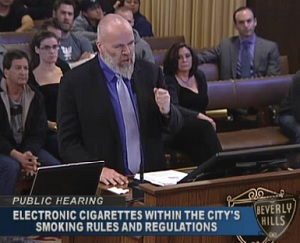 John Cameron: Arguably the standout speaker from the public comment was John Cameron – once CEO of SafeCig and brother of James Cameron (of Avatar and Terminator 2 fame) – arguing that e-cigarettes should be embraced “unilaterally.” He stressed that nicotine was not a carcinogen or a mutagen, and argued that e-cigarettes represent the first true opportunity to stop the suffering caused by smoking. He was greeted with fierce applause, which was probably unexpected by the council-members, and was soon hushed.
John Cameron: Arguably the standout speaker from the public comment was John Cameron – once CEO of SafeCig and brother of James Cameron (of Avatar and Terminator 2 fame) – arguing that e-cigarettes should be embraced “unilaterally.” He stressed that nicotine was not a carcinogen or a mutagen, and argued that e-cigarettes represent the first true opportunity to stop the suffering caused by smoking. He was greeted with fierce applause, which was probably unexpected by the council-members, and was soon hushed.
The Panel’s Comments
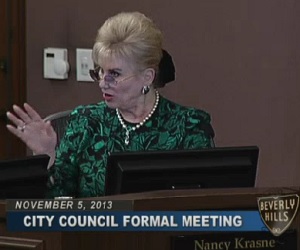
Council Member Nancy H. Krasne: The council-members had undoubtedly heard enough by that point, since even the speakers themselves were becoming acutely aware of how repetitive it was becoming, and it was time for them to share their thoughts. Nancy Krasne was the first to speak on the topic, tackling the issue with all of the intellectual grace of a toddler pondering why the square block won’t fit through the round hole. What’s the age for buying these things, again? Not 21? What’s a hookah? Who funded these studies? They're not consumer reports? On and on it went, until she unveiled her miserably uninformed opinion on their safety, “saying they are safer than cigarettes is like saying driving 75 mph is safer than driving 90 mph.” Why she assumes they’re only 16 percent safer is anybody’s guess – in fact, even if they were only ten times safer (it’s probably more like 100 times), it would be like saying driving at 9 mph is safer than driving at 90 mph, which I would most definitely agree with.
She complained about not liking chemicals (despite being made of them), not wanting nicotine in her system (assumedly meaning she avoids potatoes and tomatoes as if they were cursed) and that it tells children smoking is cool. She pointed out that tobacco companies had lied to us before. Overall, she was clearly crippled by her inability to separate vaping from smoking in her argument, although she was still opposed to the moratorium on sales.
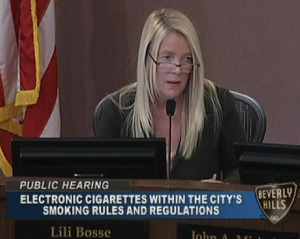
Vice Mayor Lili Bosse: Dr. Julian Gold was in favor of both proposals – but we’ll address his points separately in a moment. Lili Bosse, the vice mayor, had several good points driven by her commitment to data, claiming that “information is power and knowledge.” Her main argument was that there is no reason to rush the decision, and no justification for the supposed “urgency” of the proposal. In fact, with the Health and Safety Commission set to issue guidance in a mere couple of weeks, she asked why they should make a decision before hearing their input. To clarify, she wasn’t opposed to the ordinances, per se; she just saw no need to act without evidence. “We have to make findings. We can’t just decide we like or don’t like something,” she said, by way of explanation. After some back and forth, she returned to the topic of the ban on sales, calling it counter-intuitive and saying “there’s no way I could ever support that.”
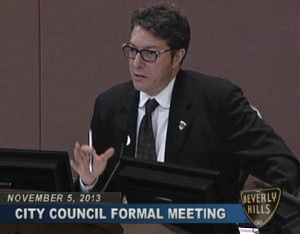
Mayor John A. Mirisch: Finally, Mayor John A. Mirisch weighed in, agreeing that it was far too inconsistent a move to ban the sale of e-cigs but leave tobacco cigarettes untouched. He argued that it was much more sensible to focus on tobacco; you know, the thing that’s really killing people. He did say he was concerned about using e-cigarettes in restaurants (because it could impact on the dining experience), which is obviously unnecessary but an understandable viewpoint. He said he would follow the evidence as opposed to forging ahead in its absence, and re-evaluate the issue if there ever arises sufficient reason to equate e-cigs with cigarettes.
Regarding the proposed moratorium on sales, he was impressively firm, “Even if [the Health and Safety Commission] recommended banning the sale of them, I’m still not going to be in favor of it. It makes no sense to me.” He continued that we can only make decision based on current evidence, “and banning everything because it might be dangerous… I think we have to use a bit of common sense and look at what is likely to, perhaps, have negative impacts.”
Dr. Gold’s Argument
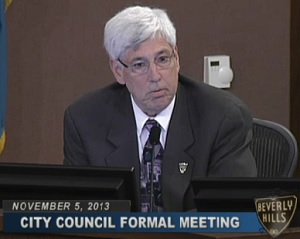
Dr. Gold is an anesthesiologist, and comments that the biggest mistake you can make in his job is to say “it’s probably OK.” His argument is that until it’s definitively proven to be OK, then it’s not OK. The current evidence, in his opinion is lacking. He dismisses the preceding hour of personal testimony from vapers as “anecdotal” and therefore not evidence. He argues that there are two choices, to either allow people to use something that is potentially dangerous or to ban it until we know it’s safe.
His backing for this position with regards to e-cigs comes in the form of the vasoconstrictive effect of nicotine, although he admits it isn’t a carcinogen. He claims nicotine is “probably” responsible for “at least some” of the vascular disease resulting from smoking. He points out how cigarette companies lied to the public in the 50s, and that Big Tobacco is starting to buy e-cig companies. He says the FDA is strongly lobbied, and that’s why warning labels on cigarettes are as small as they are today.
To Dr. Gold, the data is currently insubstantial, and therefore it’s right to err on the side of caution and place a temporary ban on e-cigarette sales until there is more evidence. This is his core stance, although he also claims that distinguishing between e-cigs and tobacco cigarettes is more trouble than it’s worth for police officers.
Addressing Such an Argument
In the end, the fact that everybody else disagreed with Dr. Gold on his suggested course of action won out, and he was left (somewhat petulantly) to call the motions officially and have nobody second them. He failed. However, his stance is likely to be commonly encountered when these discussions reach federal level. So, is it a reasonable opinion?
Firstly – and as hardly needs addressing – comparisons with the history of deception from the tobacco industry are meaningless and futile. E-cigarettes are anti-smoking, intrinsically. Vaping proponents are ex-smokers looking to help others do the same; there is no reason to suspect foul play, especially in the absence of any evidence of it. Similarly, the “difficulty” in distinguishing between the two is just downright non-existent. Even with cig-a-like models (which aren’t that common), all it takes is a quick look at the tip: if there’s ash – it’s a cigarette; if it’s a plastic tip, it doesn’t smell bad, and lights up in an unusual color – it’s an e-cig. Only very rarely will it require police officers to do so much as approach somebody to confirm that they aren’t openly breaking the law in front of the cops.
SEE ALSO: Vaping is Not the Same as Smoking
The stronger argument he makes is basically the precautionary principle, but in order to use it to justify a sales ban he presents two possibilities (classically speaking, the horns of a dilemma) where in fact there are more than two possible outcomes. It’s reasonable to want to avoid unnecessary harm, but for a true application of the principle the mechanism of harm must be scientifically plausible. As Mayor Mirisch points out, we have to act on the data we currently have. That data supports the conclusion that e-cigarettes are roughly as risky as approved nicotine replacement therapy products.
SEE ALSO: E-Cigs Are Not a Public Health Hazard
This is why Dr. Gold must present his argument in a careful way for it to hold any power. He puts it as either allowing people to continue doing something potentially dangerous or to ban it until we know it’s safe. Looked at in this way, it’s obviously reasonable to not want people to continue doing something potentially dangerous. But these are not the only two outcomes. What if, as the sum total of current evidence suggests, e-cigarettes have a magnificent potential to save lives? There is a mirror version of his argument which his “analysis” of the potential risks is wholly ignoring: either we ban something that is saving people’s lives – thereby driving them back to a definitively fatal habit – or we allow it to continue until there is any evidence of significant risk.
The correct approach is to use the best available science to determine how much of a risk could plausibly be presented by both potential courses of action, considering all possibilities. As The Precautionary Principle.eu notes, “Actions should be chosen that are proportional to the seriousness of the potential harm, with consideration of their positive and negative consequences, and with an assessment of the moral implications of both action and inaction.”
In other words, to support his argument, Dr. Gold must ignore the likely moral implications of acting to ban e-cigarettes and present only two of the numerous possible outcomes. It is extremely plausible that some Beverly Hills based vapers – faced with up to two years of no e-cigarettes – would go back to smoking for good, later contract a smoking-related illness and die. We know these risks exist, and we know that they’re significant. In addition, he must also ignore the current sum total of evidence, which is the only thing we can possibly work on. E-cigarettes are much safer than cigarettes. If cigarettes were as new as e-cigarettes, it’s reasonable to assume we’d have evidence of their potential for serious health complications by now.
Finally, the action taken must be proportional to the potential risks. Since the Drexel University research (a review of over 9,000 measurements of e-cig vapor) found that chemicals were generally only found in less than 1 percent of accepted occupational safe exposure thresholds, the potential risks are absolutely miniscule. Therefore, even according to precautionary thinking, the limitations imposed on e-cigarettes should be absolutely miniscule.
Conclusion – A Sign of Things to Come?
For Beverly Hills, we have a victory for reason and science, but the same may not be true at Federal level. The announcement from CASAA prompted a fantastic turnout for this meeting, passionate pleas and a strong opposition to the proposals. If this is the type of response the FDA can expect, then hopefully the outcome can be pushed in the same direction. Thankfully for vapers, the anti-vaping movement seems to rely almost exclusively on junk science and faulty reasoning; we just need to get good at pointing it out.

